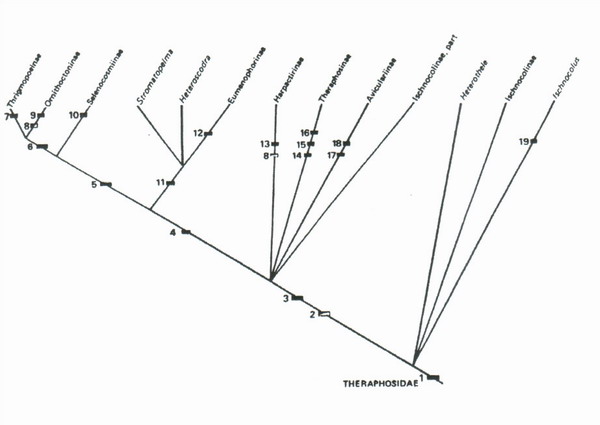Interrelationship between representatives of family THERAPHOSIDAE.
(On the base of publication of Samuel D. Marshall, Robert J. Raven & Walter R. Hoeh)
Doubt regarding the history of phylogenesis within the Theraphosidae, has hampered attempts to understand evolutionary trends within the group and to establish a stable classification system. Several different classification schemes for the Theraphosidae there was offered in recent years (Raven 1985, Smith 1990, Schmidt 1993). However, only R. Raven proposed a phylogeny for the group. While certain clades have remained fairly stable, the placement of some genera has been problematic (for example, Ephebopus, Psalmopoeus, Hapalopus).
Monophylia of family Theraphosidae as a whole (taken by R. Raven, 1985) concluded in presence of clearly denominated scopula on tarsus of legs in combination with toe pads.
The presence of clearly denominated scopula on tarsus of legs confesses as most obvious synapomorphy of family (Coddington and Levi, 1991), But there is a parallelism among closely related family Barychelidae (R. Raven, 1985).
In 1995 Goloboff has expected that, as monophylia so and paraphylia of family Theraphosidae strictly is not supported. It has noted that group, formed by Paratropididae and Theraphosidae, with exclusion of subfamily Ischnocolinae, is fixed on the grounds of absences of rows of teeths on anterior claws of male tarsus.
Interrelationship between representatives of family Theraphosidae obviously can be established only for several subfamilies.
Subfamily Theraphosinae Is in tetrachotomy with Avicularinae, Harpactirinae and a part of Ischnocolinae (see picture). These four groups have the following general features: The presence of clearly denominated scopula on tarsus of legs, absence of third claw obn tarsus of legs (established by R. Raven, 1985), and also rows of teeths on anterior claws of male tarsus is absent or reduced (Goloboff, 1993).
Below are last data got on the grounds of last (2004) publication:
«A test of alternative phylogenetic hypotheses for the interrelationship of THERAPHOSIDAE using a cladistic analysis of morphological traits» (Raven 1985, Smith 1990, Schmidt 1993).
To test alternative hypotheses of theraphosid interrelationships, there was obtained a morphological data matrix containing 33 characters representing both morphological and behavioral features. Used characters were obtained from Raven (1985), Perez-Miles et al. (1996; with amendments) as well as characters derived by authors for the present analysis. The character states were obtained from direct observation of specimens and/or from the literature for 31 species representing 31 genera within the Theraphosidae (= ingroup) and one species Sason colemani representing the family Barychelidae (=outgroup). The parsimony algorithm from PAUP was employed to generate phylogenetic trees from the data matrix.
PAUP found eight equally parsimonious trees of 95 steps and the strict consensus tree obtained was as follows: (((((((((Acanthoscurria, Aphonopelma), (Brachypelma, Pamphobeteus)), (Ceropelma, Cyclosternum, Grammostola, (Lasiodora, Theraphosa))), Hapalopus), ((Avicularia, Tapinauchenius), Ephebopus), (Ceratogyrus, Eucratocelus, Pterinochilus), (Heterothele, Holothele)), (((Citharischius, Hysterocrates), Phoneyusa), (Heteroscodra, Stromatopelma))), ((Chilobrachys, (Coremiocnemis, Lyrognathus)), (Poecilotheria, Psalmopoeus))), ((Cyriopagopus, Haplopelma), Thrigmopoeus)), Barychelidae).
Given analysis, in general, supports the phylogeny of R. Raven (1985).
There was no support for the placement of Psalmopoeus to subfamily Aviculariinae are found, as proposed by Schmidt (1993), but instead support its placement in the Selenocosmiinae, as proposed by R. Raven (1985).
There was found support to placement of genus Ephebopus to Aviculariinae as proposed by Lucas et al. (1991) by got data, as opposed to placement it in the Theraphosinae (R. Raven, 1985).
Genus Hapalopus has been placed in the New World Ischnocolinae (Schmidt, 1993; Rudloff ,1997) and Theraphosinae (R. Raven, 1985; Perez-Miles et al., 1990). Given analysis supports the latter placement (to Theraphosinae), although Hapalopus does not have a sister group relationship with any of the analyzed genera.
The structure of the New and Old World Ischnocolinae has long been debated (R. Raven, 1985; Schmidt, 1993) and and findings that the east African Heterothele and the Puerto Rican Holothele (=Ischnocolus) are sister taxa is surprising given the observation that the subfamily Ischnocolinae is a problematic group and that the Old and New World ischnocoline taxa probably do not together represent a monophyletic group (R. Raven, 1985; Schmidt, 1993).
As a result of given studies are mapped two behavioral features onto the strict consensus tree: life style and egg sac type.
While theraphosid lifestyles are highly diverse, we crudely categorized them as either arboreal or terrestrial and found that arboreality has evolved independently at least three times – once each in the Aviculariinae, Selenocosmiinae and the Eumenophorinae.
Theraphosid egg sacs may be free (an unattached spheroid carried by the female) or attached to the silk lining the interior of the retreat. While most of representatives of family Theraphosidае have free egg sacs, attached egg sacs have evolved independently at least three times – once in the Harpactirinae and twice in the Eumenophorinae {Citharischius and Heteroscodra + Stromatopelma}*.


picture: Cladogramma of subfamilies of Theraphosidae (by: R. Raven, 1985)
*Here, authors include subfamily Stromatopelminae in Eumenophorinae as a junior synonym.